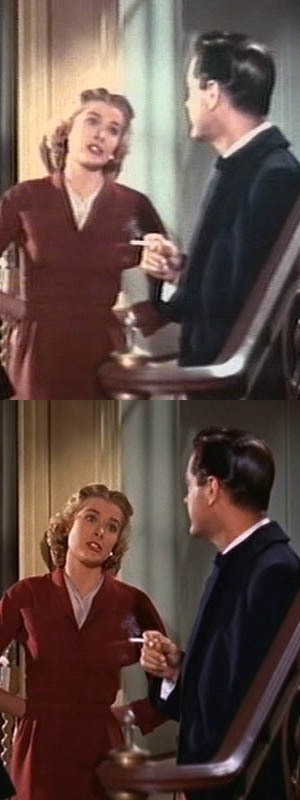 The combination of digital TV and DVD recorders can, unlike VCRs and analogue TV, make it worthwhile to record broadcasts for permanent retention. In general, purchasing the DVD of a movie or a TV show is better, quality-wise, but not always. For one thing, there are thousands of movies that are not available on DVD, and may never be. For another, there may be constraints on a DVD that make it something you’re not particularly keen on.
The combination of digital TV and DVD recorders can, unlike VCRs and analogue TV, make it worthwhile to record broadcasts for permanent retention. In general, purchasing the DVD of a movie or a TV show is better, quality-wise, but not always. For one thing, there are thousands of movies that are not available on DVD, and may never be. For another, there may be constraints on a DVD that make it something you’re not particularly keen on.
Take Alfred Hitchcock’s 1954 thriller, Dial M for Murder. There is a DVD version available in Australia, but I decided not to buy it. That’s because I already had a copy, admittedly poor, of the movie and because the Australian DVD distributor decided to reformat the Australian release as widescreen. They did this by cropping the top and bottom of the movie. (The linked review says that this movie was only available as part of a four-movie pack, but it now appears to be available separately.)
Pan and scanning widescreen movies into 4:3 is bad enough, but at least you can see that when DVDs first came out almost all TVs were of a 4:3 aspect ratio, and people were used to this format from video tapes. There may have been some justification. But cropping an old movie to widescreen!
Anyway, I picked up my copy of Dial M at the street markets in Hong Kong three years ago and it really wasn’t good, being fuzzy, washed out and in NTSC format. But it was in the original aspect ratio format and watchable.
The other night one of our commercial TV stations broadcast the movie, so I decided to record it. At least, I reasoned, it would be in PAL format. I used a Topfield TF5000PVRt digital TV tuner, recording onto its hard disk. Later I copied this to the hard disk of a Pioneer DVR-530H DVD recorder using an S-Video connection (the highest quality input provided by the Pioneer) using the MN23 mode (which notionally gives 105 minutes of recording time on a blank, single layer DVD-R). I edited the advertisements out in video mode. The results were very impressive. I suspect that the source of the TV broadcast must have been a restored version of the movie. Despite the station identifier watermark and the occasional bottom-of-the-screen banner, and the movie identifier splash screens which preceded each advertisement (the audio from the end of the previous scene sometimes faded into the start of the splash screen, so I left these in), the result was far better than my Hong Kong DVD.
As you can see from the pictures to the right. The top one is a detail from the Hong Kong version, and the bottom from the TV version, as recorded by the Topfield/Pioneer combination. The bottom one is at the original vertical resolution, while the top one was scaled up by twenty per cent (480 to 576 pixel vertical resolution) to match the size.
I know which one I prefer
Of course, all this could take a step up in quality if DVD recorders incorporated digital TV tuners. That will happen eventually, of course, but in the meantime, the consumer can get excellent results with a good standard definition digital tuner and DVD recorder combination.
You can achieve even better results by installing a digital TV tuner card in your computer, but that’s another story.
UPDATE (Wednesday, 29 March 2006, 11:04 am): Link to Topfield TF5000PVRt fixed, thanks to Jai Kemp from Topfield.
